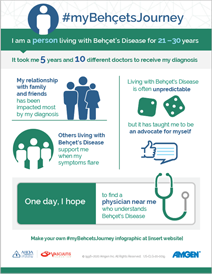You are now leaving BehcetsConnection.com
Click "LEAVE" to continue or click "STAY" to return to BehcetsConnection.com
with Behçet’s Disease
From diagnosis to daily life, each person’s experience with Behçet’s Disease is different. Create a personalized infographic by answering a brief questionnaire about your journey as a patient or caregiver of a loved one with Behçet’s Disease. Then help raise awareness by sharing your personal journey with Behçet’s Disease on social media using #myBehcetsJourney.










